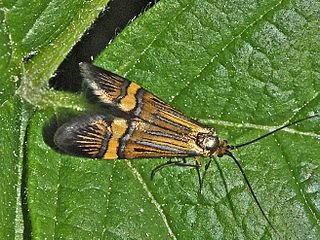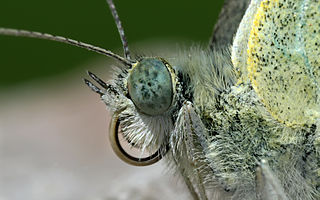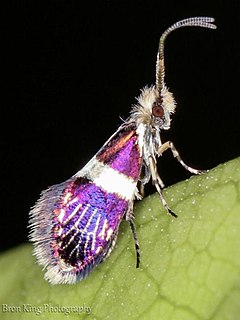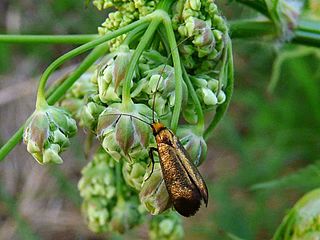
The brimstone moth is a moth of the family Geometridae. The species was first described by Carl Linnaeus in his 1758 10th edition of Systema Naturae. It should not be confused with the brimstone butterfly Gonepteryx rhamni.

Ceratomia amyntor, the elm sphinx or four-horned sphinx, is a North American moth in the family Sphingidae. The species was first described by Carl Geyer in 1835. It has a wingspan of 3+1⁄4-4+1⁄2 inches. As the name suggests, the larvae (caterpillars) feed on elm trees (Ulmus), but they can also be found feeding on birch (Betula), basswood (Tilia), and cherry (Prunus). When the caterpillars are ready, they crawl to the bottom of the host tree, where they crawl underneath the soil and pupate and may overwinter underground if late enough into the year. Vegetable growers should be aware of this larvae due to its insatiable appetite. One of these larvae are capable in devouring huge amounts of plant's foliage and even succulent stems.

Daphnis nerii, the oleander hawk-moth or army green moth, is a moth of the family Sphingidae. It was described by Carl Linnaeus in his 1758 10th edition of Systema Naturae.

The Blastobasidae are a family of moths in the superfamily Gelechioidea. Its species can be found almost anywhere in the world, though in some places they are not native but introduced by humans. In some arrangements, these moths are included in the case-bearer family (Coleophoridae) as subfamily Blastobasinae. The Symmocidae are sometimes included in the Blastobasidae as subfamily or tribe.

The longhorn moth or yellow-barred long-horn is a diurnal lepidopteran from the moths family Adelidae.

The green longhorn is a lepidopteran from the moth family Adelidae, the fairy longhorn moths.

Ecliptopera silaceata, the small phoenix, is a moth of the family Geometridae. The species was first described by Michael Denis and Ignaz Schiffermüller in 1775.

Nematopogon robertella is a moth of the family Adelidae. It is found in Europe.

Eriocrania unimaculella is a moth of the family Eriocraniidae found in Europe. It was first described by the Swedish naturalist Johan Wilhelm Zetterstedt in 1839. The larvae feed inside the leaves of birch, making a mine.

The external morphology of Lepidoptera is the physiological structure of the bodies of insects belonging to the order Lepidoptera, also known as butterflies and moths. Lepidoptera are distinguished from other orders by the presence of scales on the external parts of the body and appendages, especially the wings. Butterflies and moths vary in size from microlepidoptera only a few millimetres long, to a wingspan of many inches such as the Atlas moth. Comprising over 160,000 described species, the Lepidoptera possess variations of the basic body structure which has evolved to gain advantages in adaptation and distribution.
Pollanisus nielseni is a moth of the family Zygaenidae. It inhabits the Australian state of Western Australia, mostly coastal areas, and has brilliantly shiny forewings. The diurnal adults are most active on sunny days. Eggs are laid on the plant Hibbertia spicata, and females touch each egg after oviposition with a tuft of hair on their abdomen, which attaches protective spines. The larvae are brightly coloured and feed on H. spicata before pupation.

Tasmantrix calliplaca is a moth of the family Micropterigidae. It is known from eastern Australia, in coastal rainforest from Finch Hatton Gorge, Eungella Range in Queensland to Elizabeth Beach in New South Wales.

Adela australis is a moth of the family Adelidae or fairy longhorn moths.
Nebulosa ocellata is a moth of the family Notodontidae first described by James S. Miller in 2008. It is found in cloud forests along the eastern slope of the Andes from south-eastern Peru south to Espiritu Santo in central Bolivia.

Adela cuprella is a moth of the family Adelidae and are found in most of Europe. It was first described by Michael Denis & Ignaz Schiffermüller in 1775 and the type locality is from Austria. They can be found flying around sallows (Salix) species during the day in April and May.

Adela flammeusella is a moth of the family Adelidae or fairy longhorn moths. It was described by Vactor Tousey Chambers in 1876. It is found in the United States from southern Washington south to the foothills and interior valleys of most of cismontane California.
Adela oplerella is a species of moth of the family Adelidae, the fairy longhorn moths. It is known commonly as Opler's longhorn moth. It is endemic to California.

Adela septentrionella is a moth of the family Adelidae or fairy longhorn moths. It was described by Walsingham in 1880. It is widespread from southern British Columbia and north-western Idaho to the Transverse Range in southern California.

Adela thorpella is a moth of the Adelidae family or fairy longhorn moths. It was described by Powell in 1969. It is found in California.
Caryocolum peregrinella is a moth of the family Gelechiidae. It is found in northern Spain, the southern Alps, Bosnia and Herzegovina, North Macedonia and Greece.
















